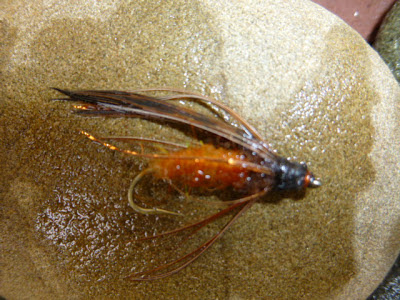 |
| October Caddis Pupae tied by Steven Bird |
If you fish Pacific Northwest streams this time of year, you should have some October Caddis imitations in your box. You seldom encounter heavy hatches of these, but they are a steady presence from late August into November, & even into the winter months on coastal streams. October Caddis are a large bug, & fish get used to seeing them through the autumn months, so the imitation is useful throughout the period.
Some entomologists believe there are at least four sub-species of the big fall sedges distributed throughout the West, & maybe more – with possible sub-species distinct to each drainage, though all very similar. Bodies are ½ to ¾ inch long; & wings 1 to 1-1/2 inches long. Size & coloration of pupae & adult phases will vary slightly according to homewater, with rusty-orange the prevailing abdomen coloration, but ranging through various shades of orange, including bright to faded pumpkin, depending on location. In some localities the orange abdomen will exhibit a faint olive hue. Thorax & legs are rusty-brown. Wings range from mottled chestnut to almost black. Pupae, overall, are lighter in coloration than adults.
October caddis are case-builders, with a 2-year life cycle. Mature nymphs begin to gather along the edges of streams in July, where they eventually anchor their cases to rocks & seal themselves within to pupate. The mature pupa chews through the door & exits the case completely, or partially, to complete emergence. Some pupa crawl out of the water onto streamside rocks & vegetation, while others complete the transformation beneath the water, & some I’ve observed emerging from midstream. Once, in inches of water, I observed an adult emerge from a pupa still partially anchored to its case, which leads me to believe that October caddis pupae don’t ride the flow to emerge, but rather, cling to bottom rocks to complete the final instar, & emerge from the bottom as winged adults; their rise to the surface quickened by their waxy, buoyant wings.
Though I prefer to fish dryflies, I must admit that soft-hackle versions of this insect have worked better for me, both winged and not. That could be due to the fact that adult OC are swift, strong flyers & trout don’t like to waste energy chasing them, while exposed pupae, cripples & drowned adults are easier prey.
Over the years, I’ve tied and fished a lot of takes on this insect trying for a workhorse producer, some of them ill-conceived, others ambiguous. Here are a few variations of a design that has proven fairly reliable:
October Caddis Pupa
Hook: #6-#8
Thread: Rusty-Brown Uni-thread
Body: Blend dyed sulfur-yellow rabbit with orange & burnt-orange antron dubbing until a pumpkin orange is achieved or to match your local caddis. Some olive fibers can be added. Twist dub on light yellow polyester sewing thread, applying just slightly more than what’s needed to cover the thread, & winding in layers to create a robust body through the abdomen and thorax area. The synthetic fibers will tend to ‘rope’ around the thread, while the rabbit will fuzz out, simulating the fuzzy abdomen of the natural. Dub over the front 1/3 of the body with chestnut-brown rabbit dubbing with guard hairs left in, to form a thorax.
Antennae: 2 fibers of fine copper flash, one on each side of the thorax. A turn of dubbing after tying in will hold them from splaying out from the sides too much.
Hackle: One turn of reddish- brown, pheasant body feather, tied in by the tip.
Head: 3 natural ostrich herls wound in front of the hackle - & finish
 |
| Wingless Pupa |
The Soft-Hackle October Caddis is a good swinging fly. I fish it dead-drift, swung, dangled, dropped back and lifted. Good pattern for sea-runs too.
Miasmic October Caddis Pupa
 |
| Cripple version with clipped turkey tail fiber wing |
 |
| Miasmic October Caddis Pupa |
Hook: #6 TMC 200R or octopus
Thread: Rusty-brown
Body: Orange dubbing
Thorax: Marabou from the base of a dyed brown mallard flank feather tied around the hook shank as a collar & extending over the abdomen area
Antennae: Two pheasant tail fibers, one on either side
Hackle: Reddish-brown pheasant rump hackle
 |
| Miasmic October Caddis Pupa tied by Steven Bird |
 |
| Miasmic October Caddis Pupa tied by Steven Bird |
Flyfish the Upper Columbia/NE Washington with Steven Bird: http://ucflyfishing.blogspot.com




